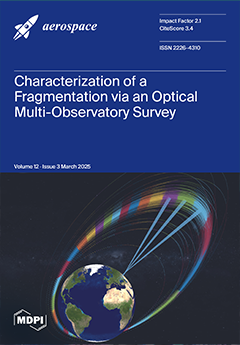The Chang’e project has completed a sampling mission of the shallow lunar soil layer; however, the exploration of the deep lunar rock layer remains unaddressed. To further investigate the feasibility of deep lunar rock drilling and identify the factors affecting the rate of
[...] Read more.
The Chang’e project has completed a sampling mission of the shallow lunar soil layer; however, the exploration of the deep lunar rock layer remains unaddressed. To further investigate the feasibility of deep lunar rock drilling and identify the factors affecting the rate of penetration (ROP) and power in low-temperature, H
2O less environment, a model was developed. This study utilized the Box–Behnken method to design a response surface experiment, where the number of polycrystalline diamond compact (PDC) cutters, the backward inclination angle, the chip removal conditions, and the temperature were considered as the key influencing factors. A response surface model for ROP and power was established. The results indicated that the number of PDC cutters, the backward inclination angle, the chip removal conditions, and the temperature significantly affected both ROP and power, with the interaction between the temperature and the backward inclination angle having a particularly strong impact on the ROP. The regression model demonstrated high predictive accuracy for both ROP and power, with goodness of fit (
R2) values of 0.95 and 0.96, respectively. The optimal combination of the backward inclination angle, number of PDC cutters, temperature, and chip removal conditions, derived from the response surface experiment, was 25°, four, −15 °C, and 1, respectively, which resulted in high drilling efficiency and low power consumption. This study offers new insights for the design of deep lunar drilling experiments, as well as support for the future optimization of drilling tools.
Full article





